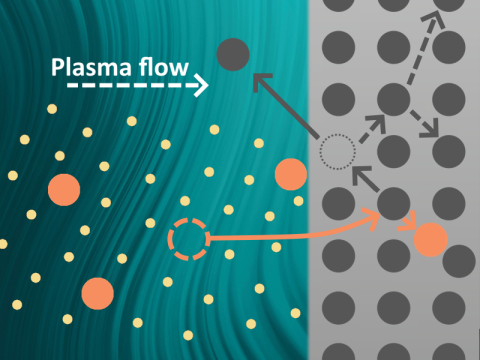Recently, two companion papers of PhD candidate Mark Cornelissen have been published in the journal Nuclear Fusion. The studies explore the role of impurity entrainment in the power exhaust of fusion devices. This achievement highlights Cornelissen’s dedication and the significance of his research in the field of nuclear fusion.
Cornelissen's research focuses on how hot plasma at the exhaust of future fusion reactors can drag along impurities. Cornelissen: “These are heavy atoms undesirable in the core plasma. Impurity entrainment – dragging impurities through the plasma flow – will play an important role in the erosion and re-deposition of the plasma-facing materials in future fusion reactors.”
High velocities
Using DIFFER's linear plasma generator Magnum-PSI to mimic ITER-like conditions, Cornelissen discovered in his first paper that the plasma can indeed sweep up impurities like argon to high velocities. This even lets them knock other atoms out of the material making up the reactor wall.
His second paper, however, holds signs for optimism: the same dense plasma tends to trap impurities close to the wall and prevent them from contaminating the core plasma. "Mark did impressive work in uncovering not just one but both these effects and writing them up in two excellent papers; a great achievement for a master's student", says Cornelissen's former DIFFER mentor Thomas Morgan.
Cornelissen is passionate about contributing to the development of a working fusion reactor. He finds it rewarding to be part of a team that combines various research findings to realise fusion energy in the future. "I think it is great that I can contribute to combining all these ‘building blocks’ into a metaphorical wall (a working fusion reactor), which is a huge challenge", he says.
Journey
Cornelissen's journey in fusion research began with a master internship in Germany, where he focused on the heat loads in stellarators. This experience sparked his interest in plasma physics and set the stage for his future endeavours. He continued his master studies at DIFFER in Thomas Morgan’s research group, where he developed a keen interest in plasma diagnostics. Cornelissen: “After completing my master’s degree in the summer of 2023, I decided to stay in the same research field. Plasma diagnostics attracted me the most, leading to my application for a PhD position on coherent imaging spectroscopy.”

In October 2023, Cornelissen started working with Roger Jaspers (TU/e), Ivo Classen (DIFFER), and EPFL colleagues Artur Perek, Basil Duval, and Christian Theiler. Their collaborative efforts focus on developing coherence imaging spectroscopy to create 2D images of the plasma flows in fusion devices. This interdisciplinary approach allows Cornelissen to gain insights from various experts and enhance his research capabilities. “Such collaborations provide valuable opportunities to connect with new people from different fields, engage in meaningful discussions, and explore new ideas", Cornelissen states.
Future steps
In March 2025, Cornelissen will embark on a new challenge at EPFL in Switzerland, where he will conduct research on the tokamak TCV. Cornelissen: "At DIFFER, I used Magnum-PSI for my research, which is great for studying the plasma-surface interactions under reactor-relevant plasma conditions. In a tokamak, however, you can study the plasma flows in the entire tokamak geometry."
Thus, Cornelissen looks forward to the experiments in Switzerland, where he will install a similar camera system for coherent imaging spectroscopy as he installed on Magnum-PSI. Cornelissen: “This camera system captures the velocity of the plasma particles from the Doppler effect, providing a 2D image of the plasma flows. Like how an ambulance’s siren changes pitch as it moves by, this camera system detects very small shifts in the colour of light emitted by the plasma particles as they travel around.”
Read more in Cornelissen’s papers:
- Erosion enhancement by impurity entrainment in the highly collisional plasmas of Magnum-PSI
- High erosion and re-deposition rates of tungsten in the highly collisional plasmas of Magnum-PSI
Author: Rianne van Hoek
Go to the News page.